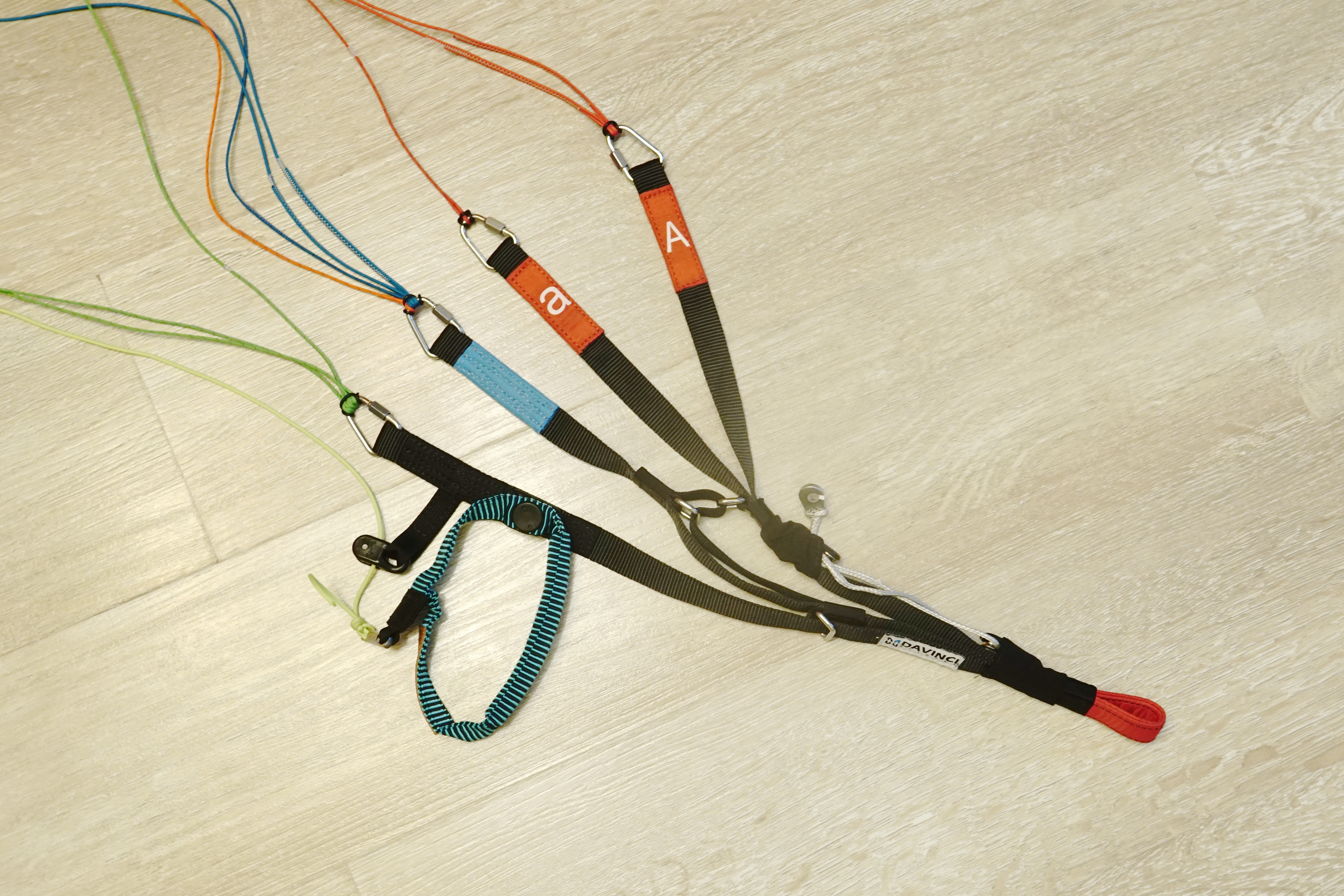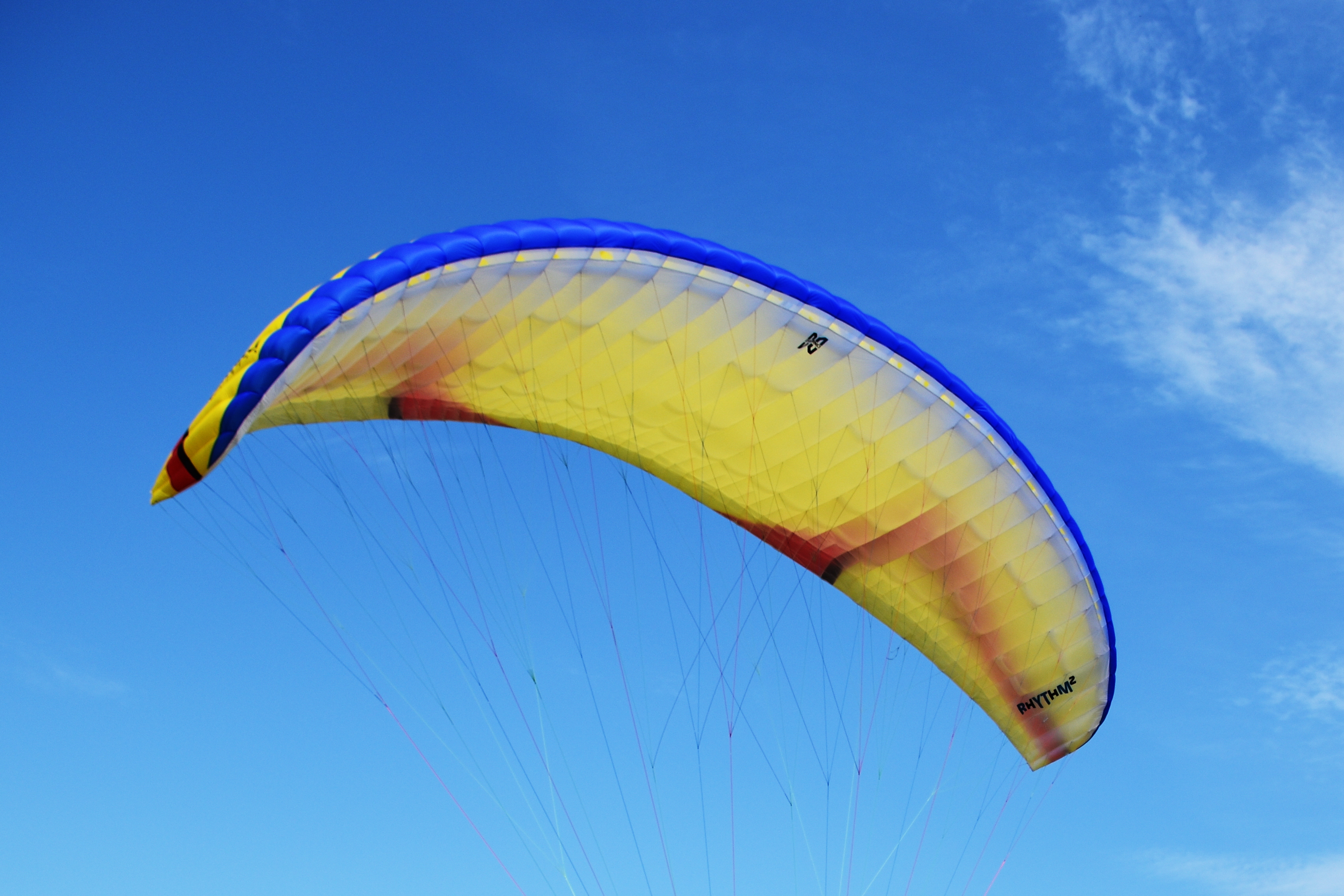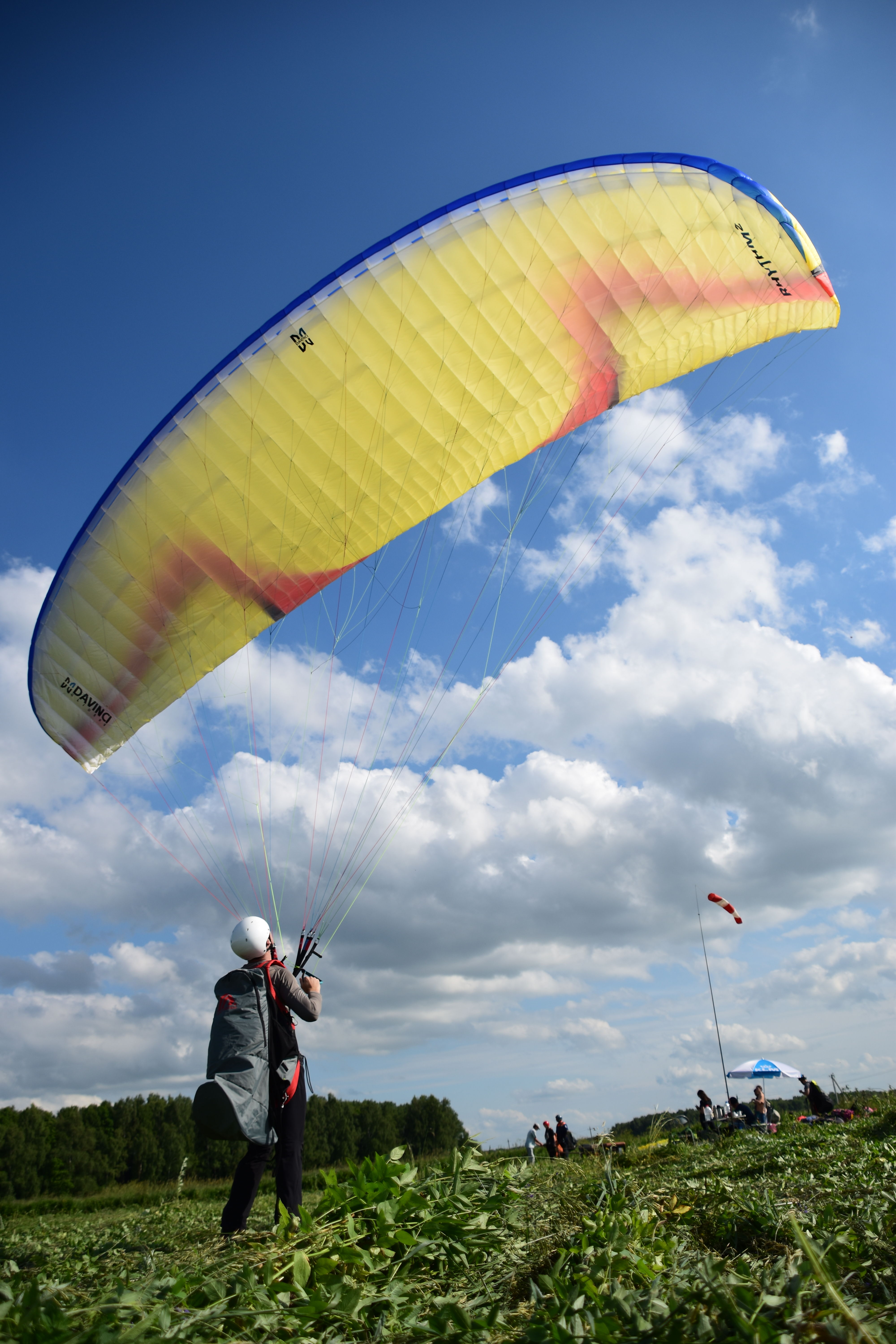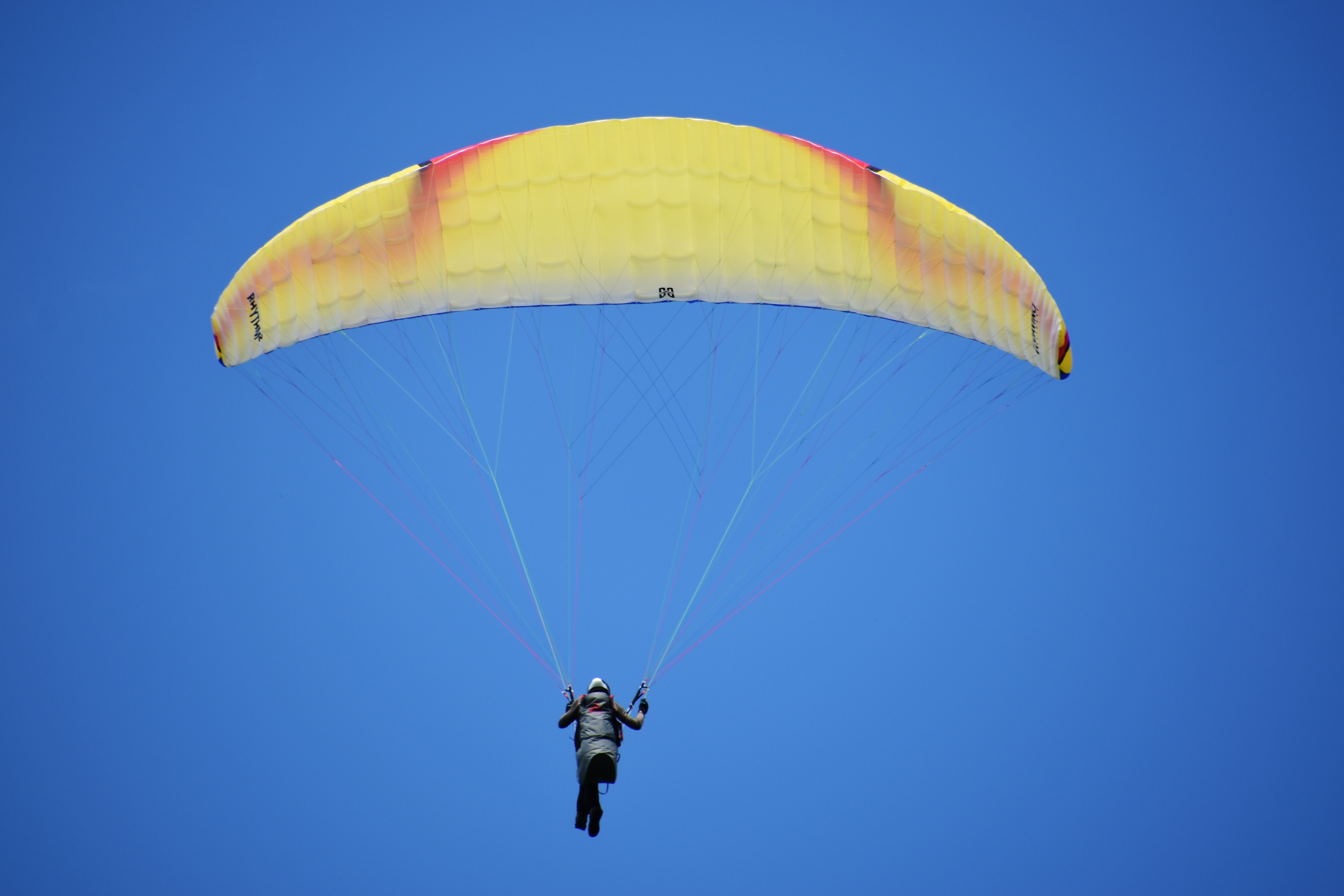The 2.0 label is always a milestone for young brands. Their first wings are often just experiments, attempts to find some empty market niche. Their followers bear much deeper insights about pilots' needs, they show how the manufacturer evolves and how it will evolve in near future. Rhythm 2 is a very convincing example of this paradigm, a step forward made with clear understanding what was already good and what needed to be improved.
Construction
Risers

Risers are the first thing You see when getting familiar with a glider, and later it's the thing You will deal with a lot of time. Rhythm's risers are quite distinctive, but they hold some important updates making them better than the risers of Rhythm The First. Easy and sober in general, these risers have all You may expect from good risers: swivels, magnets, dyneema line speed system... The manufacturing quality is quite decent, nothing to object to.There's however some space for further improvements. Very basic plastic body pulleys, the steel connectors dangle inside webbing loops which appear to be slightly too large, no handles, bridges or loops for rear risers control, webbings instead of plastic retainers... Damn perfectionism, it's just a pair of good risers, sorry ;)
Lines
Surprise, surprise! It's puzzling to see that each riser accumulates lines from more than a half-wing! Of course this leads to some overlap which may appear a mounting issue at first glance. But it's made intentionally! The manufacturer claims augmented stability and super easy recoveries after asymmetric collpases. Okay, can believe in that... and it's really so (see the text below). I was less positive about weight shift control but, strangely, it's no problem with Rhythm 2, maybe because the overlap is rather modest (3 sections, less than 1 meter of wingspan). Taking the overlap out of consideration, the lineset is rather classical and well done. The lines scheme is also classical: A2A'1B4C3.
Canopy

Build quality
Surface smoothness
A typical DaVinci glider, and it's a positive statement. The manufacturing quality is on par with most big paragliding companies, the cloth is the trendy PU-treatened Myingjin told to be more durable than Skytex. The wing geometry and section number tell about no-ambition, typical EN A-labelled wing created for maximum comfort and safety. Compared to Rhythm 1, Rhytm 2 has some changes in shape and construction, and they're not palliatives, it's a much deeper update or even a totally new design. The so-called Smart Nose Plus is one of the most important changes, and once airborn this new Rhythm appreciably differs from its predecessor!
Takeoff and groundhandling

Groundhandling
Takeoff
Unfortunately it was no wind and winch towing, so didn't feel it in details. It appears that the inflation is a bit slow but steady, the glider comes overhead calmly and need minimal brake input to correct its position.
Flight

Soaring and sink rate
Sink rate in straight flight
Sink rate in spiral
Come on, it's EN A! Gliders having this label are generally created for maximal fun and safety, but Rhythm2 has at least one strong point here: the sink rate. I was at the very top of my Rhythm2 weight range, but the thermal efficiency was much above my expectations. This glider has a very compact and slow thermal turn with perfectly low sink rate. While flying in weak conditions of russian flatlands i didn't feel any thirst for lower sink! The glider was on par with low and even mid EN B gliders, only high EN B and higher rated wings could outperform it in terms of sink rate. Impressive!
Turn ability
Brakes efficiency
Weight shift efficiency
Rear risers control
Slow airspeed behaviour
Definitely a strong point for Rhythm2! Didn't expect that. The brake efficiency is higher than average, and, despite the relativley big efforts on brakes, the glider reacts to brake input in a fast and straightforward manner (compared to most EN A gliders). It's not as sharp as Phi Symphony, but it's perfect for target pilots who definitely don't have elevated piloting skills. It's also very impressive how compact this Rhythm may turn! It allows to be massively slowed down, and turns calmly and gently, with unexpectedly low sink rate. The reactions to weight shift are fine-tuned: just what you expect from an EN A machine, not too sharp, very easy to deal with.
A couple of words about rear risers control. There's no trendy bridges, even no handles there, and this could mean that rear risers control is not the trick for this Rhytm. In fact, it IS! From my point of view this Rhythm is very pleasant while being controlled by rear risers. Okay, it's not a crazy race machine, but it's a perfect tool for learning how to use rear risers while flying at full speed.
Low airspeed behavour is what You expect from EN A glider. I'm not a precision landing competitor so i just can say that brakes efficiently kill the glide, and You need the really long and hard pull to reach the stall.
Comfort and feedback
Comfort
Feedback
Another i-didnt-expect-that! Rhythm2 is well dampened (even for EN A), just some cloth crisp may occur while entering narrow thermal cores. The glider instantly gives a vey compact and homogenous feeling, it's a "toy glider" ready to play, giving no negative emotion to its pilot. But, strangely, Rhythm2 also gives a generous amount of feedback. It's difficult to describe how it occurs... okay, let's just say that the "language" the Rhuthm "speaks" with pilot is very easy to learn and understand. Most part of that "language" are changes of airspeed and variations of brake loads. The riser feedback is less marked but still present. Rhythm2 markedly pitches back while entering the core and regains pitch and speed leaving the core behind. These pitches are however limited in amplitide which stays more than acceptable for an easy school glider.
Accelerated flight
Speed gain
Speed system effort
Speed system travel
It's not a race machine! And i'ts okay. The speed gain measured between trim and full speed is +10 km/h, typical for this kind of gliders. The Rhytm 2 remains calm and friendly at max speed, it's very usable, and for sure it will be the same in the rough staff.
Glide
Measuring glides is rocket science, comparing glides requires very very long parallel flights. Okay, didn't have chance to fly tip to tip with other EN A labelled gliders, so the things below will be totally subjective. Let's say i wasn't disappointed.The glide appears to be more than acceptable for this kind of wings: enough for flying XC in strong conditions or for peaceful soaring above the flatlands. For sure there are EN A wings with better glide, but they are much more demanding and require much more flying skills than Rhythm 2.
Dynamics and energy retention
Dynamics
Energy retention
More or less on par with other school level EN A gliders. The energy retention is well marked, but the buildup and dissipation of energy are quite smooth. Rhythm 2 is able of doing ample wingovers if the pilot knows how to ask about. The landing swoop in no wind conditions is also well marked, but don't rely on a massive flare: once the brakes are pulled at 100% this glider gently dissipates the extra horizontal speed instead of converting it into changes of vertical speed.
Dangerous flight regimes
Asymmetric collapse
Non-event, mabe because of Smart Nose implanted into Rhythm2. The collapse is relativbely easy to induice, going 20-25% chordwise. The reinflation comes in always instantly, giving no time for big surges and marked course change.
Frontal collapse
Generally the same feeling! The reinflation is so fast that the glider has no time to surge and/or to loose more than ~5 meters of height. Perfect!
Spin out of thermal spiral
Here Rhythm2 didn't shine (okay, it's the first weak point i could find!). To initiate the spin, a very long inner brake travel is needed. The brake effort near the stall point is also high. What is less pleasant: the stall occurs on the whole half-wing (it's more typical to see the wingtip stalling first), so you need to rise the inner hand quickly.
Pros
- Unexpectedly efficient thermalling, tight turn with low sink rate
- Pleasant overall behavior
Cons
- Spin out of thermal turn not perfect
Thanks
Special thanks to^
- Rinat Sabitov (DaVinci dealer in Russia) for offering the glider
- Distan paragliding school for help with additional equipment
- Vector paragliding school for help with additional equipment
- ASA paragliding school for help with additional equipment
Copyright
- Foto: I. Tarasova, A.Tarasov
Model
| Year | 2021 |
| Brand | DaVinci |
| Homologation | EN C |
| Positioning | mid EN C |
Conditions
| Flight sites | |
| Harnesses | |
| Total flight weight | 95 kg |
Technical data
| Flat area, sq. m. | 25 |
| Flat A.R. | 4,8 |
| Flat span, m | 11 |
| Projected area, sq. m. | 21,6 |
| Projected A.R. | 3,61 |
| Projected span, m | 8,9 |
| Cells, total | 38 |
| Cells, closed | 8 |
| Flattening, % | 13.8 |
| Cord max, m | 2,81 |
| Cord average, m | 2,28 |
| Lines height, m | 6,78 |
| Lines scheme | A2A'1B4C3 |
| Accelerator travel, mm | 120 |
| Takeoff weight, kg | 70-95 |
| Glider weight, kg | 4,44 |
| Size | S |
Materials and components
| Upper surface, leading edge | MYUNGJIN | MJ40 MF |
| Upper surface except leading edge | MYUNGJIN | MJ40 MF |
| Bottom surface | MYUNGJIN | MJ40 MF |
| Ribs, supported | MYUNGJIN | MJ38 HF |
| Ribs, unsupported | MYUNGJIN | MJ32 HF |
| Lines, upper cascades | TNL 80 | |
| Lines, middle cascades | TNL 145 | |
| Lines, main (lower) cascades | TNL 400 | |
| Lines, brakes | TNL 400 | |
| Risers, webbing | Guth&Wolf GMBH | 20mm webbing |
| Risers, pulleys | LW RILEY PTY LTD |



















































